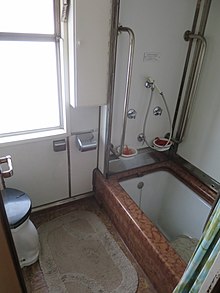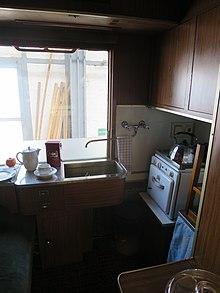DR saloon car 10207
| Salon car 10 207 Bln | |
|---|---|
|
Salon car 10 207 Bln in the DB Museum Koblenz
|
|
| Numbering: | 10207 Bln (1937) |
| Number: | 1 |
| Manufacturer: | Brothers Credé wagon factory |
| Year of construction (s): | 1937 |
| Axis formula : | 2 × Görlitz type bogies |
| Genre : | Salon 4ü-37b |
| Gauge : | 1435 mm ( standard gauge ) |
| Length over buffers: | 23,500 mm |
| Top speed: | 200 km / h (today) |
| Seats: | 5 compartments, one salon |
The saloon car 10207 of the Deutsche Reichsbahn was built in 1937 for the Reich Minister for Public Enlightenment and Propaganda , Joseph Goebbels . Later it served as a saloon car for the Federal Minister of Transport . It is preserved as a museum in the DB Museum Koblenz .
description
Delivery status
The saloon car 10207 is a skirted car , based on the style of the most modern express train carriages of the Deutsche Reichsbahn for international traffic at the end of the 1930s . It was accepted by the manufacturer on February 23, 1938.
The entrance area in front of the salon was designed as a further small salon, followed by the large salon in the length of three window axes. A conference table with seven movable armchairs was placed here. A music cabinet was built into the front wall . Both rooms took up the entire width of the car. This was followed by a corridor with side-by-side compartments : First - mirrored in their floor plan - two “apartments”, each consisting of a living / sleeping area with an adjoining toilet / washroom. Between these two wet cells there was a hip bathtub that could be made equally accessible or closed with sliding walls from both sides. In front of the wet rooms there was an inner connecting corridor between the two living / sleeping compartments, in addition to and parallel to the side corridor that reached from the salon to the entry area at the other end of the car. Two further sleeping compartments were connected to the two apartments, with the same technical equipment as the sleeping car of the time . Equipped with a bunk bed each, two people could spend the night there. These two compartments could be connected by opening a wide door. This was followed by another sleeping compartment for an accompanying conductor . A toilet, accessible from the final, second entrance area, completed the spatial program.
Reconstruction by the DB
The Deutsche Bundesbahn had the vehicle converted and renovated by Wegmann & Co. in Kassel so that it could be used as a saloon car for the Federal Minister of Transport : the facility was worn out from previous use. The entry area in front of the salon was narrowed in order to gain space in the main salon. A wall unit was installed as a new separation. This was removed a few years later and replaced by a glass wall. Instead of the music cabinet, a desk was installed, and a small kitchenette in the companion compartment. The car also got an electric heater .
In 1970/71 it was upgraded for a speed of 160 km / h. For this, the old were bogies of type Görlitz by such the type Minden-Deutz replaced. In 1980 the maximum speed limit was increased to 200 km / h and the traditional green paintwork was replaced by the colors of the Trans Europ Express and Intercity traffic , red / beige.
commitment
Reichsbahn time
The saloon car cost 384,457 RM to buy and was reserved for Joseph Goebbels' personal use. It was based in Berlin Anhalter Bahnhof . Usually it was attached to other trains as a “single runner” . It was used very often and was in the Hanover area at the end of the war , where it was confiscated by the British occupying forces on May 14, 1945 . This used it for the purposes of the military government and for this purpose it was located in the Bad Oeynhausen train station . Among other things, the British High Commissioner Brian Robertson used it .
German Federal Railroad
In 1950 the car was briefly in Frankfurt am Main , then in Cologne . But it was not handed over to the Deutsche Bundesbahn until April 16, 1951. This assigned him to the Federal Minister of Transport from March 23, 1952, at that time Hans-Christoph Seebohm .
From around mid-1978, the car could also be rented by private interested parties. This was done for the price of 20 first- class tickets plus a provision fee. In the same year Queen Elisabeth II drove in the car from Bonn to Mainz during her state visit to the Federal Republic of Germany . And in November of the same year, rock star Eric Clapton used the vehicle. The last Federal Minister of Transport to use the car was Günther Krause . The car has been parked since 1993 and taken out of service on April 30, 1996.
Numbers
The vehicle has been renamed several times:
| number | annotation |
|---|---|
| 10 207 Bln | 1938-1945 |
| 10 207 Han | 1945-1949 |
| 10 207 Cologne | 1950-1966 |
| 10 307 Cologne, Salon4üg (e) | 1966-1967 |
| 51 80 89-40 307-6, [WG] Sugt | 1967-1970 |
| 51 80 89-80 307-7 | 1970-1980 |
| 51 80 89-90 307-5, WGSüg | 1980– |
Museum object
Classified as historically valuable, the saloon car came into the holdings of the Nuremberg Transport Museum , which assigned it to its branch in Koblenz , where it can be viewed today.
swell
- Walter Haberling: Reichsbahn saloon car. Types and uses during the Reichsbahn and Bundesbahn times . Freiburg 2010. ISBN 978-3-88255-679-7 , pp. 108-117.
- Description on the object in the DB Museum Koblenz.
Web links
Remarks
- ↑ The former saloon car No. 1 of Kaiser Wilhelm II has been running on the Deutsche Reichsbahn since 1946 under the same number and must not be confused with the vehicle described here.
- ↑ New number because the top speed has been increased to 160 km / h.
- ↑ New number due to the increase in the maximum speed to 200 km / h. The car also bears this designation as a museum vehicle today.




